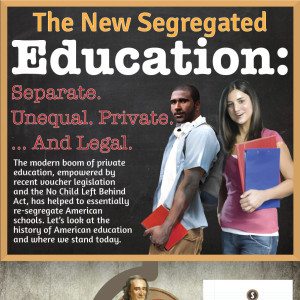The New Segregated Education: Separate. Unequal. Private. … And Legal
The modern boom of private education, empowered by recent voucher legislation and the No Child Left Behind Act, has helped to essentially re-segregate American schools. Let’s look at the history of segregation in American education and where we stand today.
1791
Thomas Paine proposes education allowance for poor to middle-income families “to allow for each of these children ten shillings a year for the expense of schooling and half a crown for paper and spelling books.” [1]
1793
The Catholic Church in France employs short-lived voucher system to combat public school creation, enabling families to afford enrollment in church-run schools. [2]
1896
In the 8-1 decision of Plessy v. Ferguson, the U.S. Supreme Court rules against Homer Plessy, an African-American who had refused to give up his seat on a train to a white man as required by Louisiana state law, claiming, “If one race be inferior to the other socially, the Constitution of the United States cannot put them upon the same plane.” [3]
1899
The U.S. Supreme Court denies an appeal for an injunction against Richmond County Board of Education’s plans to fund a white-only high school and close down a black-only school in the same district. [3]
1952-1955
In Brown v. Board of Education, a case combining arguments against five distinct school boards across the country, the Supreme Court declared segregation “inherently unequal,” and therefore unconstitutional. In a subsequent ruling, the Supreme Court delineated a plan for state governments to implement school integration. [3]
1956
County School Board of Prince Edward County v. Griffin: Virginia Legislature enacts a tuition voucher law, permitting school boards to close public schools and open privately run segregated academies in their place. Although the Supreme Court of Virginia upholds the decision, the U.S. Supreme Court on appeal declares it unconstitutional. [3]
1968
Green v. School Board of New Kent County: A Virginia county “freedom-of-choice” plan creates separate black and white schools but gives all residents a choice of which school their children will attend. Because 115 African-American students elected to attend the primarily white school and precisely zero white students (and 85 black students) chose to attend the black school, the U.S. Supreme Court declared the plan ineffective and unconstitutional. [4]
Percentage of African-American students in the south attending integrated schools [4]
1968-69: 32%
1970-71: 79%
1989
Wisconsin Legislature initiates school voucher program, giving low-income students in Milwaukee financial assistance to enroll in private schools.
12
Number of public schools in Milwaukee participating in the voucher system from 1994 to 1995 [2]
- 4 of those schools had become 100% African-American
- 4 other schools were predominantly African-American (above 70%)
- 1 school was 93% Hispanic
- 3 schools were mostly white
1995
Ohio Legislature enacts Cleveland voucher program, paying up to $2,250 in tuition per student, choosing from 49 eligible private schools, provided that the schools (a) operate within the Cleveland school district; (b) meet state education standards; and (c) accept students according to rules established by the superintendent. [5]
2002
Zelman v. Simmons-Harris: In a 5-4 decision, the U.S. Supreme Court upholds the constitutionality of the voucher system, declaring it “entirely neutral with respect to religion.” Dissenting Justice David Souter labeled the decision “potentially tragic.” [5]
Percentage of white students in typical African-American student’s school [6]
1970-71: 32.0%
1980-81: 36.2%
1991-92: 34.9%
2001-02: 30.7%
2006-07: 29.6%
2009-10: 29.2%
1994
Hartford Board of Education approves a contract with Education Alternatives Inc., a for-profit company, to take over the school district.
1996
The Supreme Court of Connecticut rules for the plaintiff, a fourth-grader at the time the case was filed in 1989, in the case of Sheff v. O’Neill, demanding that the highly segregated and privatized Hartford district be integrated.
2010
15% of African-American students in the U.S. attend schools with less than 1% white students. [7]
14% of Hispanic students attend schools with less than 1% white students. [7]
In 1970, nearly 80% of students in the U.S. were white. [7]
By 2009, the white student population dwindled to just over 50%.[7]
Hispanic student population has risen from 5 to 23% since 1970. [7]
Twenty years ago, the average minority student attended a school where 1 in 3 students were from low-income families. That proportion has since doubled. [7]
2014
Despite programs allowing minority students to transfer schools, less than 10% of students of color in Hartford attend an integrated school. However, 42% of all students now attend integrated schools. [8]
25%: Percentage of black students in the South who attended predominantly segregated schools (over 90% of student body comprised of racial minorities).
53%: Percentage of black students in the South (where desegregation orders have been removed) in 2014 who attend predominantly segregated schools. [9]
Sources:
[1] http://fee.org/freeman/detail/history-of-the-voucher-idea
[2] http://www.illinoislawreview.org/wp-content/ilr-content/articles/2004/5/KAlexander.pdf
[3] http://www.uscourts.gov/educational-resources/get-involved/federal-court-activities/brown-board-education-re-enactment/history.aspx
[4] http://www.vahistorical.org/collections-and-resources/virginia-history-explorer/civil-rights-movement-virginia/green-decision
[5] http://www.edweek.org/ew/articles/2002/06/27/42voucher_web.h21.html
[6] http://www.epi.org/publication/unfinished-march-public-school-segregation/
[7] http://www.washingtonpost.com/blogs/answer-sheet/post/school-segregation-sharply-increasing-studies-show/2012/09/22/5b34111a-04c6-11e2-91e7-2962c74e7738_blog.html
[8] https://www.aclu.org/racial-justice/sheff-v-oneill
[9] http://www.theatlantic.com/politics/archive/2014/04/segregation-forever/360912/



9 thoughts on “The New Segregated Education”